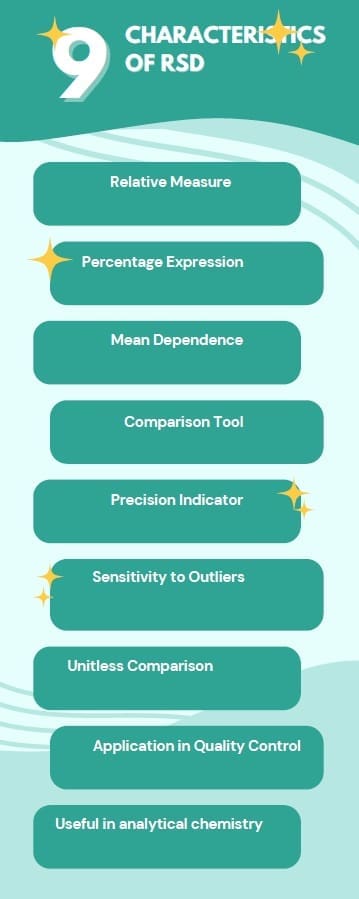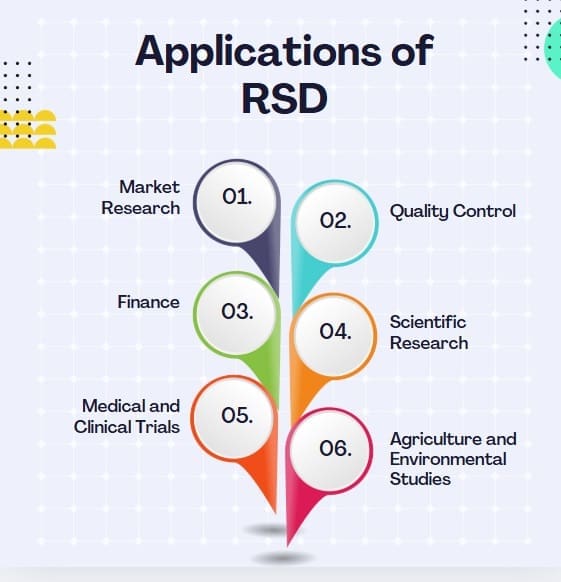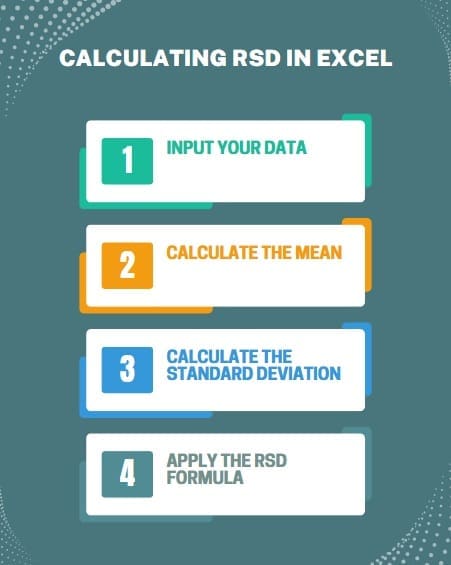In the field of statistics and data analysis, measuring data variability is crucial for understanding the consistency and reliability of data points. One of the most widely used metrics for this purpose is the Relative Standard Deviation (RSD). It provides a means of understanding the variation of data relative to the mean of that data.
This measure can be essential for quality control, financial analysis, and even scientific research.
Table of contents
What is Relative Standard Deviation (RSD)?
The Relative Standard Deviation (RSD) expresses the standard deviation of a dataset as a percentage of its mean. The formula to calculate the RSD is straightforward, but the implications are significant when analyzing the precision of measurements, especially in fields that require high accuracy and consistency.
People also refer to the RSD as the coefficient of variation (CV), although they sometimes use these two terms in slightly different contexts. When the standard deviation of a dataset is small relative to the mean, it indicates greater precision, and the RSD is low.
Conversely, if the standard deviation is large compared to the mean, the RSD will rise, indicating a greater degree of variability.
Relative Standard Deviation (RSD) is a statistical measure that expresses the standard deviation of a dataset as a percentage of the mean (average) of that dataset. Essentially, it tells you how much the data varies relative to its average value.
Here’s a simplified breakdown:
Standard Deviation: Measures the absolute amount of variation or spread of data points around the mean.
RSD: Measures the relative amount of variation, making it easier to compare the variability of datasets with different means.
How to Calculate RSD?
To calculate RSD:
- Calculate the standard deviation of your data.
- Calculate the mean (average) of your data.
- Divide the standard deviation by the mean.
- Multiply the result by 100 to express it as a percentage.
RSD is useful for:
- Comparing the precision of different measurements or datasets.
- Assessing the reliability of analytical methods.
- Evaluating the consistency of manufacturing processes.
- Analyzing financial data to assess risk.
In short, it provides a standardized way to understand how much variation exists in a dataset relative to its average.
Characteristics of RSD

Relative Standard Deviation (RSD) has several key characteristics:
Relative Measure:
RSD expresses variability as a percentage of the mean. This makes it a relative measure, not an absolute one.
Percentage Expression:
It is always presented as a percentage, which simplifies comparisons between datasets with different scales.
Mean Dependence:
RSD is directly influenced by the mean. A small mean can lead to a large RSD, even with a small standard deviation.
Comparison Tool:
It’s excellent for comparing the precision of different datasets, especially when their means vary significantly.
Precision Indicator:
RSD is often used to assess the precision of measurements or analytical methods. A lower RSD generally indicates higher precision.
Sensitivity to Outliers:
Like standard deviation, RSD is sensitive to outliers. Extreme values can disproportionately affect both the mean and standard deviation, thus impacting RSD.
Unitless Comparison:
Because it’s a percentage, RSD allows for unitless comparisons, making it useful across different types of measurements.
Application in Quality Control:
It’s widely used in quality control to monitor the consistency and reliability of processes.
Useful in analytical chemistry:
It is very often used to validate the quality of analytical methods.
Interpreting RSD Values
Interpreting the RSD value is simple, but it requires some understanding of what the RSD tells us about data variability:
Low RSD (<10%): This indicates that the data points are relatively close to the mean, and the data has low variability. The measurements are consistent, and the process or system producing the data is considered precise.
High RSD (>10%): This suggests that the data points are more spread out from the mean, indicating greater variability. High RSD values often signal issues with consistency or precision in the measurement process.
Understanding RSD in Context
The interpretation of RSD depends on the nature of the dataset. For example, in manufacturing, a low RSD is highly desirable because it indicates consistent quality. On the other hand, in fields like stock market analysis, a higher RSD might be acceptable due to the inherent volatility of financial markets.
Applications of RSD

People use the Relative Standard Deviation in numerous fields for different purposes, most commonly in areas where precision and variability are key. Some of the most common applications include:
- Analytical Chemistry: In analytical chemistry, researchers often use RSD to assess the precision of measurement techniques, such as spectrometry or chromatography. A low RSD indicates that the measurement technique is reliable and repeatable, which is critical in experiments that require accuracy.
- Quality Control: In quality control in manufacturing, RSD is used to assess the consistency of products. If a manufacturer consistently produces items with low RSD, it indicates that the production process is stable and the products are of high quality.
- Finance: In finance, RSD is often used to measure the volatility of asset returns. The RSD in this case helps analysts compare the riskiness of different investments. A higher RSD indicates greater variability in returns, which may suggest higher risk.
- Scientific Research: RSD plays an important role in scientific research, particularly in experimental design and data interpretation. Researchers use RSD to evaluate the reproducibility of experiments and determine whether their results are consistent.
- Medical and Clinical Trials: In medical and clinical trials, researchers use RSD to assess the variability in test results, drug dosages, or treatment outcomes. Researchers aim to minimize RSD in their data to ensure that the conclusions drawn are statistically significant.
- Agriculture and Environmental Studies: In agriculture, RSD is used to analyze the consistency of crop yields, soil quality, or the effectiveness of fertilizers and pesticides. The ability to compare variability across fields or years is essential in improving agricultural practices.
Advantages of Using RSD
Unit Independence: One of the main advantages of RSD is that it is a dimensionless quantity. Unlike standard deviation, which is expressed in the same units as the data (e.g., grams, liters, etc.), RSD is expressed as a percentage. This makes it ideal for comparing datasets that have different units or scales.
Relative Comparison: RSD is useful for comparing variability between datasets with different means. For instance, you can compare two datasets with very different magnitudes of data using their RSD to assess relative variability.
Ease of Use: RSD is straightforward to calculate and provides a quick way to assess precision. Researchers, analysts, and quality control professionals often use it to make data-driven decisions.
Limitations of RSD
Mean Sensitivity: RSD is highly sensitive to the value of the mean. If the mean is very small (near zero), RSD can be misleadingly high, even if the standard deviation is small. This is why RSD is not suitable for datasets where the mean is zero or near zero.
Not Suitable for Negative Values: Since RSD relies on the ratio of standard deviation to the mean, you cannot use it for datasets with negative or zero values. In these cases, interpret the standard deviation separately from the mean.
Does Not Account for Skewed Distributions: RSD assumes that the data follows a roughly normal distribution. If the dataset is skewed, the RSD may not accurately reflect the true variability of the data.
RSD vs. Standard Deviation
While both standard deviation and RSD measure the variability of data, they are used in different contexts. Standard deviation gives the absolute measure of variability, expressed in the same units as the data, and is useful when comparing datasets that have similar magnitudes.
On the other hand, RSD normalizes the standard deviation relative to the mean, making it especially useful when comparing datasets with different scales or units. In short, RSD is a relative measure, while standard deviation is an absolute measure.
Difference Between Standard Deviation (SD) and Relative Standard Deviation (RSD)
| Feature | Standard Deviation (SD) | Relative Standard Deviation (RSD) |
| Definition | Measures the absolute amount of variation or dispersion of a set of values. | Measures the relative amount of variation or dispersion of a set of values as a percentage of the mean. |
| Units | Same units as the original data. | Percentage (%) |
| Purpose | To quantify the absolute spread or variability of data around the mean. | To compare the variability of different datasets with different means; to assess the precision relative to the average. |
| Interpretation | A larger SD indicates greater absolute variability. | A larger RSD indicates greater relative variability. |
| Use Cases | Useful for describing the variability of a single dataset. | Useful for comparing precision between different datasets, especially when their means are significantly different. |
| Sensitivity to Mean | Independent of the mean. | Directly dependent on the mean. |
| Comparison Across Datasets | Difficult to compare datasets with different means directly. | Allows for easy comparison of variability across datasets with different means. |
| Impact of Outliers | Sensitive to outliers, as they can significantly increase the SD. | Sensitive to outliers, especially when the mean is small. |
| Application in Analytical Chemistry | Used to assess the absolute variability of measurements. | Used to assess the precision of analytical methods and compare method performance. |
| Application in Finance | Used to measure the volatility of returns. | Used to compare the risk-adjusted returns of different investments. |
| Application in Manufacturing | Used to monitor process variations and ensure product consistency. | Used to assess the relative consistency of production processes and compare process stability. |
| Application in Research | Used to describe the variability of experimental data. | Used to compare the precision of measurements between different experiments or studies. |
| Advantages | Provides a direct measure of data spread. | Normalizes data, allowing for meaningful comparisons; easy to understand as a percentage. |
| Limitations | Difficult to compare variability across datasets with different means. | Can be misleading when the mean is close to zero; sensitive to outliers, especially with small means. |
| Example | If a set of measurements has a mean of 10 and a standard deviation of 2, the SD is 2 units. | If the same set of measurements has a mean of 10 and a standard deviation of 2, the RSD is (2/10) * 100% = 20%. |
Calculating RSD in Excel

Excel is a powerful tool for calculating RSD. Here’s a quick guide to calculating RSD in Excel:
- Step 1: Input your data
Enter the dataset into a column in Excel. - Step 2: Calculate the Mean
Use the formula =AVERAGE(range) to calculate the mean. - Step 3: Calculate the Standard Deviation
Use the formula =STDEV.P(range) to calculate the standard deviation. - Step 4: Apply the RSD Formula
Use the formula = (Standard Deviation / Mean) * 100 to calculate the RSD.
Final Words
The Relative Standard Deviation (RSD) is an essential statistical tool for understanding the precision and variability of data, especially when comparing datasets with different means or units. It is widely used across industries, including quality control, analytical chemistry, finance, and scientific research.
By providing a percentage-based measure of variability, RSD enables easy comparison and helps organizations maintain high standards of consistency and reliability in their processes.

About Six Sigma Development Solutions, Inc.
Six Sigma Development Solutions, Inc. offers onsite, public, and virtual Lean Six Sigma certification training. We are an Accredited Training Organization by the IASSC (International Association of Six Sigma Certification). We offer Lean Six Sigma Green Belt, Black Belt, and Yellow Belt, as well as LEAN certifications.
Book a Call and Let us know how we can help meet your training needs.



















